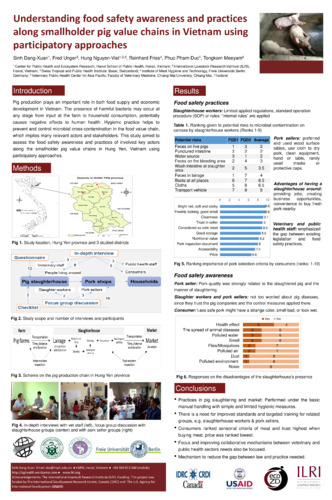Understanding food safety awareness and practices along smallholder pig value chains in Vietnam using participatory approaches
Abstract
Pig production plays an important role in both food supply and economic development in Vietnam.
We assessed the food safety awareness and practice of involved key actors along the
smallholder pig value chains in Hung Yen, Vietnam using participatory approaches. Data collection
included quantitative (checklists, questionnaires) and qualitative (in-depth interviews
and focus group discussions-FGD) tools and was done in three districts of Hung Yen. All survey
tools were developed and pre-tested. Checklists (n=22) and questionnaires (n=12) followed
random sampling procedures. The respondents for in-depth interviews (n=24) were randomly
selected, while the participants for FGDs (n=5) were recruited by convenience. Data collection
was done between January and June, 2013. Descriptive statistic was used for quantitative
data, while content analysis was used for qualitative data. The outline for data collection for
included groups and stakeholders (slaughterhouse workers, pork sellers, veterinary and public
health staff, people living around slaughterhouses, pork consumers) was structured around food
safety, diseases and health risks. Differences in what some groups found important or unsafe,
based on their occupational priorities or labour focus were identified by using ranking tables
and analysed accordingly. Analyses show that for slaughterhouse workers and pork sellers the
food safety risks were highest and linked to lack of training, or relying only on “learning by doing”
an experience provided by other workers or sellers. People living around slaughterhouses
expressed concerns about health effects but also pointed out the advantages of their proximity to
slaughterhouses, such as job opportunities and easy access to fresh pork. Pork consumer groups
were more concerned about sensorial criteria (e.g. freshly looking, bright red colour) and expressed
also some awareness on pork quality. Veterinary and public health staff emphasised
the gap between existing legislation and food safety practices. Findings provide information
on food safety awareness and practices along various actors and stakeholders. There is a need
for improved standards, targeted training and collaborative mechanisms between veterinary and
public health authorities to better manage the food production chain.

